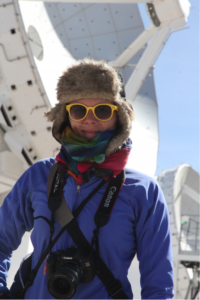The U.S. National Science Foundation National Radio Astronomy Observatory (NSF NRAO), in partnership with several leading Mexican universities and research institutes, has announced a series of landmark agreements and meetings aimed at advancing Mexico’s role in the Next Generation Very Large Array (ngVLA) project.
Recent News
Astronomers Discover a Superheated Star Factory in the Early Universe
Astronomers have uncovered a previously unknown, extreme kind of star factory by taking the temperature of a distant galaxy using the ALMA telescope. The galaxy is glowing intensely in superheated cosmic dust while forming stars 180 times faster than our own Milky Way.
Astronomers Share Largest Molecular Survey To-date: GOTHAM Legacy Data Goes Public
Astronomers in the “GBT Observations of TMC-1: Hunting Aromatic Molecules” research survey, known as GOTHAM, have released a spectral line survey with largest amount of telescope time ever conducted, charting more than 100 molecular species only found in deep space.
The Big Show Begins
Planetarium Show Highlighting People, Places, and Science of Astronomy Begins Production

ACEAP Ambassador and Big-ACT team member Renae Kerrigan visits the ALMA high site. The ALMA observatory is located at an elevation of more than 16,000 feet; above more than 50% of the Earth’s atmosphere. (Credit: Spuck, T./ACEAP/AUI/NSF – 2015)
Washington DC: In the most remote locations on the planet, people are working to uncover mysteries throughout the universe… and most are not astronomers. Big Astronomy in Chile through Dome+ (Big-ACT) explores a new model to deliver a unique learning experience for planetarium visitors around the world. By integrating virtual interactions with those living and working at the observatories, curricular resources, and the planetarium show, Big-ACT will advance the public’s awareness of the National Science Foundation (NSF) funded observatories in Chile, and the diverse people and careers it takes to make big science possible today. With support from NSF-Advancing Informal STEM Learning program, Associated Universities Inc. (AUI), partners with Michigan State University, the California Academy of Sciences, Astronomical Society of the Pacific, Association of Universities for Research in Astronomy, National Optical Astronomy Observatory, Gemini Observatory, and the Atacama Large Millimeter/submillimeter Array to complete the new $2 million project.
Big-ACT is set in Chile where the dry, dark, sky, and remoteness creates an ideal site to observe the universe. By the year 2022 it is expected that nearly 70% of the world’s ground-based observing infrastructure will be located there, and the US and other countries are investing billions of dollars in astronomy in Chile. Big-ACT introduces audiences to the wide variety of personnel involved in advancing astronomical discovery. “When people think of astronomy they often imagine astronomers peering through telescopes,” says AUI President, Adam Cohen, “they are unaware of the STEM village it takes to make exploration of the cosmos possible.” Big observatories today employ electrical and mechanical engineers, technicians, data analysts, machinists, heavy equipment operators, maintenance personnel, artists, cooks, etc. Each of these individuals play an important role in making astronomical discoveries possible.
Beyond the fascinating places and people involved in astronomical research, the show includes the fruits of the research itself. “We are excited by the opportunity this project presents to both formal and informal STEM educators,” explains Tim Spuck, AUI Director of Education and Public Engagement and Principal Investigator (PI) for Big-ACT, “Astronomy excites learners of all ages. We can use the power of astronomy to help individuals understand that they can be part of amazing science and discoveries without necessarily becoming a PhD astronomer. We want every person attending the planetarium show to be able to connect the people they see to someone they know or someone they themselves can one day become.” The Dome+ model will also support engagement beyond the planetarium show through a dynamic web portal. The portal will include learning activities, interviews with observatory personnel, and a schedule of live virtual sessions with those working at the observatories. The curricular resources and planetarium show will be made available in both English and Spanish for dissemination here in the US and Latin America. Big-Act will be coming soon to a planetarium near you as well as the World Wide Web in the spring of 2020.
For additional information, please contact Tim Spuck, Big-ACT PI and AUI Director of Education and Public Engagement at [email protected] or Joe Flannery, Assistant Education and Public Engagement Administrator at AUI at [email protected].
[Header image: Cerro Mayu Observatory – View of the Milky Way from the touristic observatory Cerro Mayu near the Cerro Tolo Interamerican Observatory (CTIO) and La Serena-Chile. (Credit: Dieterich, M./ACEAP/NSF – 2017)]
Recent News
NSF National Radio Astronomy Observatory and Mexican Institutions Sign Historic Agreements to Advance ngVLA Collaboration
The U.S. National Science Foundation National Radio Astronomy Observatory (NSF NRAO), in partnership with several leading Mexican universities and research institutes, has announced a series of landmark agreements and meetings aimed at advancing Mexico’s role in the Next Generation Very Large Array (ngVLA) project.
Astronomers Discover a Superheated Star Factory in the Early Universe
Astronomers have uncovered a previously unknown, extreme kind of star factory by taking the temperature of a distant galaxy using the ALMA telescope. The galaxy is glowing intensely in superheated cosmic dust while forming stars 180 times faster than our own Milky Way.
Astronomers Share Largest Molecular Survey To-date: GOTHAM Legacy Data Goes Public
Astronomers in the “GBT Observations of TMC-1: Hunting Aromatic Molecules” research survey, known as GOTHAM, have released a spectral line survey with largest amount of telescope time ever conducted, charting more than 100 molecular species only found in deep space.
